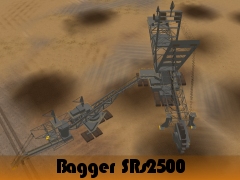Bucket wheel excavators are another design of continuously operating excavators. The buckets are mounted at the rim of a revolving drum. As the drum rotates, each bucket in turn scoops up material. The bucket wheel is located at the end of an arm, which can pivot upwards. During the revolution of the drum, the contents of each bucket are falling inside the drum and through a system of deflectors on a conveyor belt. The conveyor belt transports the excavated material along the bucket wheel arm to the central pivot of the excavator. There it falls on to another conveyor belt, which transports the material to a loading facility for e.g hopper cars.
A bucket wheel excavator consists of the lower works with the crawlers and the upper works with the bucket wheel arm, the counterbalancing arm and the mechanism for raising and lowering the bucket wheel arm. The upper works can pivot through 360 degrees around the vertical central pivot axis.
Initially bucket wheel excavators suffered from rather low forces at the cutting edges of the bucket wheel, limiting them to removal of soft materials like lignite, sand or gravel.This problem partially overcome, allowing removal of hardened or even frozen sediments too, modern bucket wheel excavators are making even inroads against the use of discontinuously operating excavators. In comparison to bucket chain excavators bucket wheel excavators are more versatile, allowing selective harvesting of e.g. lignite in geologically disturbed strata. Because of that they are gradually replacing bucket chain excavators.
Bucket wheel excavators are also widely used at storage and mixing sites for ores and black coal.
The first large bucket wheel excavators were introduced into German and Polish lignite opencast mining during the 1930ies. They continued to be built after WW II in both parts of Germany as well as Czchechoslovakia and the Soviet Union. They are ranging in size between less than 100 t to more than 70,000 t gross weight.
The biggest bucket wheel excavators are employed in the lignite mining areas of the Rhineland in the West of Germany, where depth of opencast mines is approaching 500 metres. They are used for both, removal of overburden and harvesting lignite. The larger bucket wheel excavators are linked to a seperate loading machine with an extenable conveyor belt bridge, which is running on its own set of crawlers. The first of the big 70,000 t class excavators were still fitted for train transport during the 1950ies and 1960ies until conveyor belts replaced train transport of both spoil and lignite. Like most other types of opencast mining equipment bucket wheel excavators are electrically powered.
The model shows a 70,000 t class bucket wheel excavator fitted for train transport. It has been created as an industry asset which can load either lignite or spoil into enabled traincars like kuid:142675:1258 and kuid2:211961:15000:1 or others. In surveyor the angles between several parts of the excavator and loading machine combination can be adjusted to local requirements. These properties as well as loading of traincars and operation of the excavator in driver are script controlled.
| $screenshot$.jpg |
29.5 kB |
| body |
|
| body / absetzer.im |
297.8 kB |
| body / bagger_fahrgestell.im |
202.9 kB |
| body / bagger_mittelbau.im |
100.5 kB |
| body / bagger_mittelbau_basis.im |
2.7 kB |
| body / bagger_mittelbau_basis.kin |
2.1 kB |
| body / bagger_oberbau.im |
180.1 kB |
| body / bagger_oberbau_basis.im |
1.3 kB |
| body / bagger_oberbau_basis.kin |
1.5 kB |
| body / bagger_oberbau_schwenkanimation.im |
1.3 kB |
| body / bagger_oberbau_schwenkanimation.kin |
3.2 kB |
| body / bagger_schaufelrad.im |
28.4 kB |
| body / bagger_schaufelrad.kin |
2.3 kB |
| body / bagger_schaufelradausleger.im |
258.4 kB |
| body / bagger_schaufelradausleger.kin |
6.9 kB |
| body / diagonalversteifung.bmp |
96.1 kB |
| body / diagonalversteifung_dunkelgrau.tga |
96.0 kB |
| body / dunkelgrau.texture.txt |
33 B |
| body / dunkelgrau.tga |
786 B |
| body / ers2500_body.texture.txt |
35 B |
| body / ers2500_body.tga |
768.0 kB |
| body / fabrikfenster_kurz.bmp |
48.1 kB |
| body / fabrikfenster_kurz.texture.txt |
71 B |
| body / fabrikfenster_kurz.tga |
48.0 kB |
| body / foerderband.texture.txt |
34 B |
| body / foerderband.tga |
48.0 kB |
| body / gelaender_rot.texture.txt |
36 B |
| body / gelaender_rot.tga |
786 B |
| body / kabel.texture.txt |
28 B |
| body / kabel.tga |
812 B |
| body / kettenglied.texture.txt |
34 B |
| body / kettenglied.tga |
24.0 kB |
| body / kreuzverband.bmp |
192.1 kB |
| body / kreuzverband_dunkelgrau.tga |
192.0 kB |
| body / maschinenraum_dunkelgrau.tga |
192.0 kB |
| body / montagekran.im |
30.1 kB |
| body / riffelplatte.texture.txt |
35 B |
| body / riffelplatte.tga |
48.0 kB |
| body / schaufelrad.texture.txt |
34 B |
| body / schaufelrad.tga |
48.0 kB |
| body / schurre.texture.txt |
30 B |
| body / schurre.tga |
24.0 kB |
| body / srs2500_gelb.texture.txt |
35 B |
| body / srs2500_gelb.tga |
786 B |
| body / verlader_band.im |
160.6 kB |
| body / verlader_band.kin |
1.8 kB |
| body / verlader_basis.im |
2.7 kB |
| body / verlader_basis.kin |
2.0 kB |
| body / verlader_fahrgestell.im |
194.8 kB |
| coal_load0.wav |
104.1 kB |
| coal_load1.wav |
104.1 kB |
| ers2500.gs |
40.3 kB |
| ers2500.tga |
16.5 kB |
| ladung_abraum0.tfx |
388 B |
| ladung_abraum1.tfx |
388 B |
| ladung_abraum2.tfx |
388 B |
| ladung_braunkohle0.tfx |
388 B |
| ladung_braunkohle1.tfx |
388 B |
| ladung_braunkohle2.tfx |
388 B |
| umwelt.wav |
96.1 kB |
| Общий объём файлов: |
3.6 MB |
 Тип: Индустрия
Тип: Индустрия